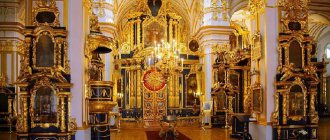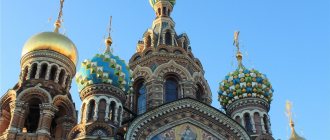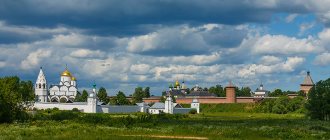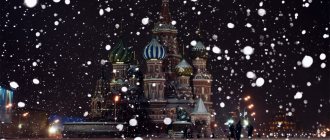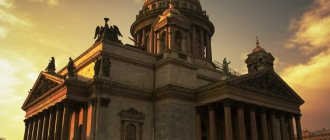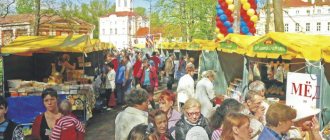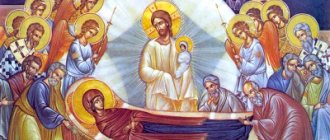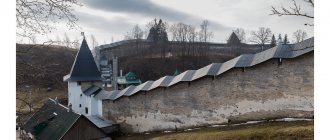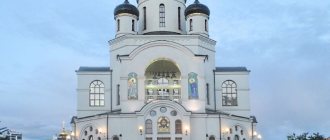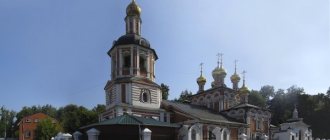Alexander Nevsky Lavra in St. Petersburg. In 1710, at the confluence of the Black River (Monastyrka) with the Neva, the Alexander Nevsky Monastery was founded, founded by decree of Peter I in memory of the victory of the Russian troops over the Swedish troops under the leadership of the Novgorod prince Alexander Nevsky. In those days it was believed that it was at this place in 1240 that the battle between the prince’s squad and the Swedes took place.
Construction of the monastery.
The construction of this monastery had both religious and political significance - Alexander Nevsky, canonized by the Orthodox Church, was considered as the divine patron of Orthodox Russians in the fight against the eternal enemy - Sweden. This saint, deeply revered by Peter, became the patron saint of St. Petersburg. In 1724, by order of Peter I, the relics of Alexander Nevsky were transferred from Vladimir to the new capital. At first they were placed in the newly consecrated Alexander Nevsky Church, and later they were transferred to the main cathedral of the monastery - Trinity.
History in dates
- 1710 - Peter I decided to build the largest monastery in the country on the Black River dedicated to Alexander Nevsky.
- 1713 – the first wooden church was built and consecrated.
- By 1720, a school for children of clergy, a printing house and an almshouse for retired soldiers were opened.
- May 29, 1723 – the relics of A.Ya. Nevsky were transported here.
- The middle and end of the 18th century - large-scale construction of buildings, churches and the main cathedral.
- 1797 - awarded the status of a monastery, i.e. a large monastery of great religious and historical significance for the country.
- In the 19th century, the Lavra flourished and expanded. Pilgrims began to come here. The collection of relics and valuable art objects was replenished.
- 1930s - Soviet authorities prohibit religious services, all monasticism is arrested.
- Only in 1957 was the parish restored, although all the buildings were damaged after the war.
- 1996 - restoration work began, the main ones were completed only after 10 years.
- 2000 - the state transferred the facility back to the authority of the diocese.
lite.35photo.pro
Alexander Nevsky Monastery.
The Alexander Nevsky Monastery was conceived by Peter as an exemplary one. Here he wanted to bring to life his idea of the “utilitarian” use of monasticism to serve the world - he conceived the monastery as a charitable, correctional, educational and medical institution. Under him, a hospital, an almshouse, a printing house and a school for children of clergy were established, which later acquired the status of a Theological Seminary and a Theological Academy - a higher educational institution of the Patriarchate (they exist to this day).
Baptism
Baptism is the first and most important rite through which a person joins the Church.
The sacrament of baptism is performed every day:
- Monday – Friday – 12.00
- Saturday – Sunday – 10.00, 12.00, 14.00
For those who want to be baptized, their relatives and godparents, an indispensable condition is to attend the public conversations, which are held daily at 15.00 in the spiritual and educational center.
To undergo the baptismal ceremony, you must have a cross and a white shirt. They are sold in the monastery shops. Persons under 15 years of age must have godparents present.
Alexander Nevsky Monastery.
The initial design of the Alexander Nevsky Monastery was drawn up by the architect Trezzini. The first to be built was the Annunciation Church, which has remained almost unchanged to this day. It is rightfully called the first Russian Pantheon - at the beginning of the 18th century. it served as a tomb for members of the royal family and prominent statesmen. Tsarevna Natalya Alekseevna, Tsarina Praskovya Fedorovna, Peter I's beloved little son Pyotr Petrovich, and ruler Anna Leopoldovna are buried here.
Abbots and governors
- Theodosius (Yanovsky) (1712 - 1721)
- N
- Varlaam (Golenkovsky) (1716 - 1721)
- Hilarion (Markov) (1721 - 1727)
- Veniamin (Falkovsky) (1727 - 1730)
- Simon (Tikhomirov) (1730 - 1732)
- Gervasy (Korda) (1732 - 1737)
- Dosifey (Lebedevich) (1737 - 1745)
- St. Sophrony (Kristalevsky) (1746 - 1753)
- Nikon (Krasovsky) (1753 - 1757)
- Jacob (Palashkovsky) (1757 - 1759)
- Ioannikiy (Brodnetsky) (1759 - 1761)
- Sylvester (Yunitsky) (1761)
- Gury, abbot. (1761 - 1762)
- Clement (Beloshapkin) (1763 - 1765)
- Hilarion (Maksimovich) (1768 - 1774)
- Ambrose (Ginovsky) (1774 - 1781)
- Afanasy (Volkhovsky) (1781 - 1788)
- Josaph (Klokov) (1788 - 1792)
- Jonah, abbot. (1792 - 1794)
- Gerasim (Knyazev) (1794 - 1795)
- Melchizedek (Short) (1795 - 1797)
- Joasaph (Chapuzhnikov) (1797 - 1799)
- Anthony (Znamensky) (1799)
- Ambrose (Protasov) (January 8 - March 1800)
- Israel (Zvegintsev) (1804 - 1808)
- Veniamin (Besnovsky) (1808 - 1809)
- Porfiry (Kirillov) (1809 - 1810)
- Gideon (Fedotov) (1810 - 1819)
- Tobias (Moiseev) (1819 - 1829)
- Palladium (Belevtsev) (1829 - 1842)
- Aaron (Petrov) (1842 - 1843)
- Veniamin (Moracevic) (1843 - 1853)
- Iriney (Bogolyubov) (September 30, 1853 - January 1860)
- Nikanor (Ilyinsky) (1860 - 1863)
- Herman (Ossiecki) (1863 - 1866)
- Polycarp (Honorsky) (1866 - 1867)
- Yuvenaly (Polovtsev) (1867 - 1871)
- Philip, archimandrite (1871 - 1873) i/o
- Sschmch. Procopius (Titov) (May 1917)
- Sschmch. Procopius (Titov) (January - April 1918)
- Gennady (Tuberozov) (April 11 - August 14, 1918)
- Artemy (Ilyinsky) (August - October 1918) acting
- Nikolai (Yarushevich) (December 14, 1919 - March 1920) acting
- Joasaph (Zhurmanov) (July - September 1922) acting
1935 - 1994 - Lavra closed
- Nazariy (Lavrinenko) (October 25, 1996 - April 17, 1997)
Alexander Nevsky Lavra.
Later, the great Russian commander Suvorov was buried in the Annunciation Church, on whose tombstone there are Derzhavin’s laconic lines “Here lies Suvorov.” The two-story rectangular building of the Annunciation Church in the Russian Baroque style served as a model for later monastic buildings - the Fedorovskaya Church and corner towers. The monastery ensemble continued to develop throughout the 18th century. A gate church in the name of the icon of the Mother of God of All Who Sorrow appeared above the entrance gate.
Routes around the monastery
Architectural ensemble
Many names of great masters are associated with the construction of that wonderful artistic and architectural ensemble of the Lavra that we see today: architects, architects, icon painters.
The original design of the monastery was created by Domenico Trezzini.
It is not surprising that during the era of wars the monastery was considered as an additional outpost of the St. Petersburg south-east. The architect’s task was to competently and harmoniously combine the spiritual, artistic and strategic components of the monastery.
By the way, the famous Nevsky Prospekt, along which guests of St. Petersburg (and us local residents) now love to wander, should have started from the Lavra. Hence its name, adopted in 1781. True, it has been transformed many times from the “Perspective Road to the Nevsky Monastery” and “Nevsky Perspektiva”, etc., to the modern sound of “Nevsky Prospekt”.
Previously, the temple was the heart of any settlement in Russia, be it a small village or the capital. So the Lavra becomes the spiritual center of St. Petersburg, and the prayers offered in its churches become the breath of the city, its pulse.
Her wondrous beauty still impresses us today.
A detailed list of all objects of the architectural ensemble of the Alexander Nevsky Lavra and their history can be found here.
From the Saints to the Annunciation Gate
The entrance to the Lavra is separated from the round square on which the monument to Alexander Nevsky stands, and into which Nevsky Prospect itself abuts, by the front Holy Gate with the gate church located above it.
It was illuminated in July 1786 in the name of the icon “Joy of All Who Sorrow.” At first, this small temple was a parish for craftsmen working in the monastery and grain producers. In 1904, a Latvian parish was opened here, where services were held in the Latvian language (existed until 1918). In Soviet times, the premises were taken over by Osoaviakhim, and then by the management of the sculpture museum. Today the temple has regained its true spiritual purpose. I highly recommend going up there. You will find yourself in an unusually bright, heavenly atmosphere created by its restorers.
Prayers are held here on Wednesday and Friday. To the left of the gate arch is the chapel of the Sorrowful Church, consecrated in 1997, along with the church bench. Let's enter this Holy Gate and head along the cobblestone street (wear comfortable shoes) to another - the Annunciation Gate, decorated with mosaic icons in the Byzantine style.
While you walk this distance, passing the bridge over the Monastyrka River with its eternal owners - pigeons, you are already tuning into a special tone and completely disconnected from the bustle behind the monastery fence.
By the way, on this route you can visit necropolises, which in Greek means “cities of the dead.” I will write about them in a separate section. So, you and I entered under the arch of the Annunciation Gate and found ourselves directly on the territory of the monastery.
Holy Trinity Cathedral
Let's head straight to the magnificent Holy Trinity Cathedral. A detailed history of its creation can be read here.
On both sides of the entrance there are church shops where you can buy candles, icons, jewelry and literature, as well as submit prayers. By the way, if you need a headscarf, you can borrow one here for free. Let us venerate the relics of the holy noble prince and other saints, 79 pieces of whose relics are in the new shrine.
To the right of the shrine is a beautiful image of Christ written by the hieromartyr Metropolitan Seraphim (Chichagov). This most talented person was amazing, possessing not only a bright mind, deep scientific knowledge, but also an artistic gift. I really love the wonderful miraculous icon of the Most Holy Theotokos, located to the left of the altar, which is called the Neva Quick to Hear. The history of this icon is very interesting. She is rightfully considered a particularly revered image in the monastery and is a copy of the Athonite “Quick to Hear”, located in the Dokhiar monastery. True, here the Mother of God is depicted without the Child. This icon was painted on Mount Athos and brought to Russia in 1877 by Russian hieromonks Athanasius and Barsanuphius.
Initially, it was located in the Alexander Chapel and miraculously was not damaged during the fire that happened there. It was possible to save the icon during the fight against God, which was primarily facilitated by the already mentioned Metropolitan Hieromartyr Veniamin (Kazansky). The shrine moved to different temples. During the blockade, she was in the Prince Vladimir Cathedral, where the miraculous Kazan Icon of the Mother of God was also preserved. In those terrible days of war, the inhabitants of the heroic city found spiritual support here. After all, the very name “Quick to Hear” meant a quick answer to prayers and aspirations. After the transfer of the Holy Trinity Cathedral to the church, in 1958 the image was transferred to it. In 2005, it was decided to rename this icon “Neva Quick to Hear”.
Of course, all the icons and relics of the cathedral are sacred. I really like stopping at the wooden sculpture of Paraskeva Pyatnitsa, which is located on the right side not far from the entrance. Some amazing warmth and kindness emanate from her. The icon first appeared in the forest near the village of Ilyeshi at the end of the 18th century. Now the Elijah Church is being restored there. The site of the miraculous appearance of the icon has been cleared and marked with a memorial cross. Every year, the local abbot, reviving ancient traditions, takes this image from the monastery on the eve of the feast of Elijah the Prophet, with which a religious procession is then carried out through the churches of the Gatchina and Volosovsky districts.
After which, on September 10, the icon solemnly returns to the Lavra.
When you walk around the cathedral, you understand that every icon here is inextricably linked with the history of Russia. That is, it is simply impossible to perceive the church separately from our state, as was once enshrined in the Bolshevik decree.
Here even foreigners, usually noisy and fussy, somehow become quiet and walk around with a reverent expression on their faces. After we have visited the main cathedral of the monastery, you can visit the necropolises and cemeteries.
Necropolises and cemeteries
I promised to talk about the Necropolises of the Alexander Nevsky Lavra, which preserve the memory of many worthy people of Russia’s past. We will move according to this map.
Immediately at the exit from the Holy Trinity Cathedral in front of you is the Cossack cemetery or the Communist site (1).
The first name was obtained as a result of the burial here, on the site of the former parterre garden, of several Cossacks who died in 1917 during the dispersal of the Bolshevik demonstration. The cemetery took on official status in 1919. It becomes the second most important “necropolis of the Bolsheviks” after the Campus Martius.
If you go around the cathedral on the right, you can go to the Nikolskoye cemetery (2) , so named thanks to the Nikolskaya Church (architect G.I. Karpov).
It is here that the cenotaph of Metropolitan Veniamin is located, as well as the graves of many prominent public and church figures. I always go to two of them - to the burial place of Metropolitan John (Snychev) and a wonderful man, confessor of the Alexander Nevsky Lavra, with whom I myself once had the good fortune to talk personally - Archimandrite Eliazar. There are always fresh flowers here.
Also at the Nikolskoye Cemetery are the graves of Lev Gumilyov, Mamin-Sibiryak, Ivan Goncharov, Baron Nikolai Wrangel, the designer of the first Russian car, Peter Frese, and many other famous people in Russian history.
Let's return to the path running between the Holy and Annunciation Gates.
If you cross the bridge (after feeding the pigeons) and move towards the exit, then on both sides there will be two more Necropolises. We will visit the famous Lazarevskoye cemetery (3) or the 18th century Necropolis - the most significant in St. Petersburg.
Imperial consent was required for burial on its territory.
The Tikhvin Cemetery (founded in 1823) and the “Necropolis of Art Masters” created here by the Soviet government (4) store not only the graves of famous cultural figures under their unique tombstones.
When you come here, you sadly remember that in addition to the famous names that can be read today on the plaques of the monuments, there were a lot of other burials that “did not fit” into the plan for creating this Necropolis.
Detailed information about all Lavra Necropolises is here.
I will write about entry prices and visiting times in a separate section below.
Monuments
- Monument 2,000 years from the Nativity of Christ. Opposite the Holy Trinity Cathedral is this seven-meter monument by sculptor E. P. Solovyova. (1)
On April 18, 2001, it was solemnly illuminated by the abbot of the Holy Trinity Alexander Nevsky Lavra, Bishop Nazarius of Kronstadt.
- Monument to those who suffered for the faith of Christ. (2)
On the winter day of memory of the Holy Blessed Prince Alexander Nevsky, December 6, 2005, in the garden in the courtyard of the Lavra, a monument also by E. P. Solovyova in the form of a cross inscribed in a circle was opened and consecrated. It symbolizes salvation through the sacrifice of Christ.
- Worship cross in the Metropolitan Garden.
The monument was erected on September 12, 2013 in the Metropolitan Garden in honor of the significant event of 2009 - the restoration of the connection between the Moscow Patriarchate and the Russian Church Abroad, which was once interrupted for political and ideological reasons. Now, according to Bishop Mark, both of our Russian churches stand together before the throne of God. This is also the work of E. P. Solovyova. (3)
- Relief panel of St. Prince Alexander Nevsky. Opened on September 12, 2013 to celebrate the 300th anniversary of the Lavra. (4)
This bronze panel is located on the wall of the Prosphora building.
- Memorial plaque in the Metropolitan building of the Lavra, at the site of the fatal wound received on January 19, 1918 by the holy martyr Peter Skipetrov. (5)
- Icon with the Konevskaya Icon of the Mother of God. Covered on July 10, 2015. (6)
This two-meter stone icon case was made in the Lavra’s workshop under the direction of the isographer and restorer D. G. Mironenko. It is located in the backyard of the monastery. Around the icon case there is a resting place for pilgrims with a decorative pond and gazebos.
Museum of the Alexander Nevsky Lavra
The monastery has its own museum, which was created with the blessing of the vicar, Bishop Nazarius. It is located in the Lavra sacristy.
The exhibition contains exhibits telling about the three-century history of the monastery. Photographs and documents, icons, priestly vestments, church utensils and much more will appear to visitors. Detailed information about the creation of the museum is here.
Entrance is possible on Wednesday and Friday from 12.00 to 17.00 and by agreement through the Lavra pilgrimage center by calling 274-16-12.
Holy names
Many names of those people who are now canonized are associated with the Alexander Nevsky Lavra. Here are some of them.
- Of course, first of all, we must remember the great blessed holy prince Alexander Nevsky.
- Also in this bright galaxy are St. Innocent, the first Bishop of Irkutsk, the Wonderworker (John of Kulchitsky), who was at one time a resident of the Lavra and received the rank of bishop here.
- Hieromartyr Metropolitan of Petrograd and Gdov Benjamin (Kazan).
- The Holy Reverend Seraphim of Vyritsky, once a brilliant Russian merchant of the 1st guild, and later a priest, a schema-monk, who repeated the feat of praying on the stone of Seraphim of Sarov during the Great Patriotic War.
His canonization took place in our time, in 2000. Today the river of believers to his chapel in Vyritsa is growing. In the fraternal building of the Lavra, in the premises of the saint’s former cell, today there is a small cozy church.
You can learn about other canonized saints, new martyrs and confessors of the Alexander Nevsky Lavra here.
Holy Trinity Cathedral.
The compositional center of the Alexander Nevsky Monastery was the Holy Trinity Cathedral, built according to the design of the architect Starov at the end of the 18th century. Trinity Cathedral was distinguished by the richness of its interior decoration, but with its own peculiarity: instead of icons, it was decorated with paintings by Van Dyck, Rubens, Bassano, and many famous Russian artists. Above the entrance to the cathedral are gilded figures of angels bearing the Order of St. Alexander Nevsky.
Visiting information and contacts
The Lavra is located at the very end of Nevsky Prospekt, in its eastern part.
Address
Embankment of the Monastyrka River, building 1, lit. A.
Where to find and how to get there
Metro
Alexander Nevsky Square.
In front of the exit there is a square with a monument to the commander, behind which you can see the yellow building of the gate church. This is the entrance to the monastery complex. Another landmark is the Moscow Hotel building located opposite.
Opening hours and cost of visiting
The monastery is available for free visits any day from 5:30 to 23:00.
Holy Trinity Cathedral , due to cleaning after church services, closes earlier - at 20:00.
You can explore the necropolis museums daily from 9:30 to 16:00 in advance, until 15:30, by purchasing a ticket at the box office.
- When purchasing a ticket to both Necropolises at once, the price will be 250 rubles
- The cost of visiting one necropolis is 150 rubles for adults
- A discounted price is set for students and pensioners – 50 rubles
Lavra divisions: contact numbers
Depending on the purpose of your visit and the question of interest, you can contact the relevant divisions of the Lavra:
Office
- opening hours: from 10-00 to 17-00
- phone: 8 812-274-17-02
Pilgrimage center
- phone: 8 812-274-16-12
Spiritual and educational center
- phone: 8 812-710-20-39
The Alexander Nevsky Monastery remains an attractive tourist attraction and a revered place for believers. National holidays, celebrations, as well as various religious events that influence spiritual education are held here.
Holy Trinity Cathedral.
The main shrine of the temple was the relics of the Holy Blessed Grand Duke Alexander Nevsky, kept before the revolution in a magnificent silver shrine made at the behest of Empress Elizabeth Petrovna. Now the cancer is in the Hermitage, and the relics themselves, transferred under Soviet rule to the Museum of the History of Religion and Atheism, have long been returned to the cathedral. The ark with the relics stands to the right of the iconostasis, and there are usually a lot of people around it.
Sunday school at the monastery
Sunday school “Unexpected Joy” appeared in 1996. More than 150 children from 5 to 15 years old study there. The education system consists of three levels, preschool, primary and secondary.
Among the disciplines taught to children are the Law of God, creative and musical activities, choral singing, Church Slavonic language, history and others. Students not only attend lessons, but also participate in worship services, conversations and creative events: Christian exhibitions and festivals.
Conversations with clergy, as well as handicraft classes, are organized for parents. The Sunday school organizes trips and excursions and a summer camp for children on Lake Ladoga.
Holy Trinity Cathedral.
Divine services in Trinity Cathedral have always been distinguished by beauty and solemnity. The choir of metropolitan singers in the monastery was in no way inferior to the court singers. Russian emperors often visited the cathedral and made rich contributions, including golden sacred vessels, golden crosses, and precious throne gospels. One of the most important holidays in the capital was the day of honoring St. Alexander Nevsky, when a solemn procession of the cross took place from the Kazan Cathedral to the Lavra and back.
Spiritual, educational and social life of the Lavra
The activities of the monastery are not limited to directly religious orientation; they are versatile and multifaceted. The Lavra has many departments that carry out creative, constructive, and educational work.
Spiritual and educational center Svyatodukhovsky
The center has been active in educational activities since 2003. His work covers the organization of various events:
- public conversations and educational courses for parishioners
- excursions and music concerts
- traditional exhibitions and fairs
- conferences, seminars, youth club meetings, health faculty
The organization of the festival of modern Orthodox sacred music Nevsky Domes also takes place with his participation.
Vocal male ensemble
Since 2010, there has been a bishop's choir at the Alexander Nevsky Lavra It consists of men. It consists of 30 people, all of them are students or graduates of Theological Schools and the Academic Conservatory of St. Petersburg.
The choir performs at services in monasteries and cathedrals , singing more than 20 Orthodox prayer songs. In addition, the group conducts touring concert activities and takes part in various art festivals. His repertoire includes outstanding classical and contemporary musical works:
- Russian church music
- folk songs
- Western European compositions
Workshops
Several workshops operate under the Alexander Nevsky Lavra:
- icon painting and restoration
- icon-case
- jewelry
- sewing
- pottery
- porcelain
- printmaking
The products of these divisions are real works of art, which can be purchased in the shops of the monastery:
- icons
- service and festive vestments of clergy
- temple decoration items
- ecclesiastical jewelry made of various metals, stones, wood and enamel
- crosses and medallions, rings
- artistic works of hand and printed graphics
- porcelain and ceramic products and souvenirs, including those for church purposes: candlesticks, lamps, vessels for holy water, icons on porcelain, household utensils, dishes, vases, children's toys-whistles.
Some workshops conduct master classes to teach a specific craft.
In addition, on February 5, 2021, a cheese workshop was consecrated in the Lavra. now on the territory of the monastery . The entire manufacturing process is carried out by the brethren of the monastery, using the highest quality milk, using modern equipment. In October we tried a new recipe with the addition of cumin.
Monastery refectory
The monastery refectory Pilgrim has been operating in the Lavra since 2004, and the Tea Room opened in 2010. When compiling the menu, the church calendar is observed here, and predominantly Lenten dishes are served. The teahouse always offers fresh monastery Lenten pastries. Priests dine in the refectory; it is also available to ordinary townspeople, tourists, and pilgrims.
The interior is decorated with original stained glass windows made by Lavra icon painters. The Tea Room contains a collection of decorative plates and ceramic products from the Lavra’s workshop.
Alexander Nevsky Monastery.
By the end of the 18th century. The Alexander Nevsky Monastery gradually turned into one of the spiritual and cultural centers of the Russian Empire. In 1797, it received the highest status of an Orthodox monastery - a monastery. The huge, fortress-like monastery occupies an entire island between the Neva, Monastyrka and the Obvodny Canal. The fortress walls, traditional for ancient Russian monastic monasteries, are replaced here by interconnected monastery buildings. The Alexander Nevsky Lavra contains several ancient cemeteries, united in the Museum of Urban Sculpture.
Refectory and tea room "Pilgrim"
Not only church servants, but also visitors and pilgrims can dine in the Prosphora building. The hall can accommodate up to eighty visitors. In the kitchen they strictly follow the church calendar and prepare a variety of Lenten foods. You can taste it directly in the refectory itself or place an order by calling in advance.
In the teahouse, visitors are offered to try baked goods made from Lenten dough. They can also be pre-ordered and picked up hot at the appointed time. There is also an interesting exhibition of decorative plates and products from the Lavra pottery workshop.
Alexander Nevsky Monastery necropolis.
In the Necropolis of the 18th century. (Lazarevskoye Cemetery) more than a thousand gravestones. Here are the graves of the great Russian scientist Lomonosov, writer Fonvizin, Pushkin’s grandfather Hannibal, architects Quarenghi, Starov, Voronikhin, Rossi, sculptors Shubin, Kozlovsky, Martos and many others, whose wonderful creations we admire while walking around St. Petersburg.
Development of the monastery complex
While the Trinity Cathedral was being built, the modern appearance of the monastery was being formed. During this time, the Fedorovsky and Spiritual buildings were completely completed and the Fedorovskaya Church was erected.
The Prosphora and Seminary buildings were completed by the mid-18th century. At the same time, the architect M. Rastorguev created a design for the Metropolitan House, and it was soon also built.
The holy gates of the monastery, from which Nevsky Prospekt begins, appeared in the third quarter of the 18th century - the gate church above them was consecrated in 1786.
In 1829, after the completion of the Obvodny Canal, the Chernaya River was divided into parts by this canal and after that the part flowing near the monastery walls was called Monastyrka.
Interesting! The river changed its flow direction and now it does not flow into, but flows out of the Neva, flowing into the Obvodny Canal.
As a result, the territory of the monastery is now delineated by three rivers. On one side there is the Neva, on the other sides there is the Obvodny Canal and Monastyrka.
Alexander Nevsky Monastery necropolis.
In the Necropolis of Art Masters (Tikhvin Cemetery) there are about 200 tombstones, many of which are striking in their sophistication and splendor. Writers Karamzin, Krylov, Dostoevsky, composers Tchaikovsky, Mussorgsky, Rimsky-Korsakov, Glinka, artists Shishkin, Kuindzhi, Kustodiev, famous artists, government and public figures are buried here. There are also graves in the Lavra from our time. Behind the Holy Trinity Cathedral is the Nikolskoye Cemetery, named after the church in the name of St. Nicholas the Wonderworker. In 2000, the first mayor of St. Petersburg, who returned the city’s historical name, Anatoly Sobchak, was buried in this cemetery. There are also the graves of State Duma deputy Galina Starovoytova and the son of Anna Akhmatova and Nikolai and Lev Gumilyov.
Trade fairs
Orthodox exhibitions and fairs are regularly organized in the Metropolitan Garden , timed to coincide with the seasons. Such an event has several components: spiritual and educational, cultural and gastronomic.
Visitors to the fair can submit prayer requests for family and friends, find out answers to questions about church life, and make useful purchases. Anyone can buy:
- church utensils, icons, candles
- seasonal natural products: honey, herbs, berries, mushrooms, nuts, dried fruits
- other delicacies from farms: meat and fish products, baked goods, cheese
- health products: herbal tinctures, ointments
- garments, fabrics
- souvenirs from masters of art
The fair program also includes performances by various musical ensembles.
Alexander Nevsky Lavra.
Now all the buildings of the Lavra, which were used by various organizations that had nothing to do with religion during Soviet rule, have been returned to the church. Having suffered greatly from the merciless passage of time and improper handling, they are being repaired and restored. The Alexander Nevsky Lavra was the main monastery of St. Petersburg, and the main monastery for women was the Resurrection Novodevichy Convent, founded during the time of Empress Elizabeth Petrovna on the site of the former Resin Court. The monastery was subsequently transferred from here, but the magnificent Smolny Cathedral, the creation of the great Rastrelli, has been preserved here.
Landscaping
Improvement around the monastery continues to this day. In 2021, a competition for projects for the restoration of the Metropolitan Garden, a landscape monument of the entire monastery complex, was announced.
Metropolitan Garden
It is located near the Metropolitan Corps and the Monastyrka River. In 1723, the German architect Theodor Schwertfeger developed a design for the park, its arrangement began : greenhouses were organized, many fruit-bearing trees and bushes were planted, and radial paths were laid. A pond was dug in the middle of the park, the water from which flowed into a canal connecting the Chernaya River with the Neva.
The territory of the park was closed along with the entire laurel complex and it was completely seized from the Russian Orthodox Church, the garden was cut down. It was recreated again in the 50s of the last century , but for a long time it remained in disrepair.
In the 90s, this place was notorious: gangster meetings were arranged in the remote corners of the Metropolitan Garden
In 2001, based on the Decree of the Russian Government, the park was declared a cultural heritage site of Federal significance. In 2012, it was again transferred to the jurisdiction of the Russian Orthodox Church , and improvement work began there.
It is planned to restore the historical layout of the garden, plant new fruit trees, and strengthen the retaining wall of the Monastyrka embankment.
Monuments
In recent years, several monuments by the sculptor Evelina Pavlovna Solovyova have been installed on the territory of the Lavra.
- 2000 years from the birth of Christ. This is an almost 7-meter monument with the image of the praying Mother of God, reminiscent of a granite chapel on a stepped base.
- For the faith of Christ to those who suffered. A 2-meter high granite cross, enclosed in a circle, was erected in memory of the martyrs who accepted death in the name of Christ. On the monument is the face of the Savior and the words: “God is not the God of the dead, but of the living. For with Him all are alive.”
- Worship cross in the Metropolitan Garden. Its installation marked the 5th anniversary of the reunification of the Russian and foreign Orthodox Churches.
In addition to these monuments, on the day of the 300th anniversary of the Alexander Nevsky Lavra, September 12, 2013 , another memorial sign was fixed This is a relief bronze panel decorating the Prosphorus building. It symbolizes the history of the monastery.
St. Andrew's Skete
Ten kilometers from St. Petersburg, on Agathon Meadow , which is located near the village of Korkino, there is a monastery named after the Holy Apostle Andrew the First-Called .
This place for solitary prayers was not chosen by chance: the Road of Death passes here, leading to the Nevsky Piglet.
The bridgehead from which Soviet troops repeatedly tried to break the blockade of Leningrad became a symbol of heroism and self-sacrifice. To perpetuate the memory of the exploits of the fallen soldiers, a large worship cross with soldiers’ helmets at the base and a crown of thorns was strengthened here.
And according to church tradition, once passed through the Agathon meadow. was considered proof of this . It was believed that this mark was from the hooves of the apostolic horse. This boulder has a reputation for having healing powers. But during the persecution of the church, the stone was destroyed, split into three parts. Only one remained in the meadow . In the summer of 1996, was near this boulder .
St. Andrew's monastery was the first, founded in 1998, during the revival of the monastery monastery. On the territory of the monastery, a church named after St. Zosima and Savvaty was built , in which regular services are held. And also a wooden bell tower with a 5-ton bell.
The construction and arrangement of the monastery continues to this day. The designed stone cathedral is awaiting its implementation.
